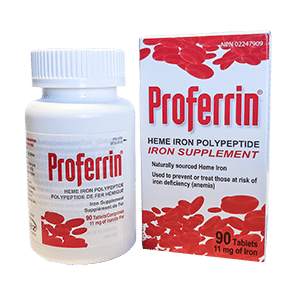Product Review
Proferrin®: Iron for Good Health
 Iron is a mineral essential for good health. Your body uses iron to manufacture hemoglobin, which is the protein found in red blood cells that carries oxygen throughout the body. Without an adequate quantity of iron, you may be at risk for iron deficiency anemia, with its accompanying symptoms that include fatigue, dizziness or light-headedness, headache, insomnia, shortness of breath on exertion, and pallor. Iron deficiency is the most common human nutrient deficiency in the US,1 and there are varying degrees of insufficiency.2
Iron is a mineral essential for good health. Your body uses iron to manufacture hemoglobin, which is the protein found in red blood cells that carries oxygen throughout the body. Without an adequate quantity of iron, you may be at risk for iron deficiency anemia, with its accompanying symptoms that include fatigue, dizziness or light-headedness, headache, insomnia, shortness of breath on exertion, and pallor. Iron deficiency is the most common human nutrient deficiency in the US,1 and there are varying degrees of insufficiency.2
Iron Supplementation
You can develop an iron deficiency for a number of reasons. These could include a poor diet, a growth spurt or other physical demand for extra nutrients within the body, insufficient absorption of dietary iron, and blood loss. Some groups of patients are at particular risk for iron deficiency, and their physicians or dietitians may recommend an iron supplement to prevent anemia. These include those who have:
- chronic diarrhea,
- blood loss from inflammatory bowel diseases such as Crohn’s or ulcerative colitis,
- celiac disease but are not following an absolutely gluten-free diet (particularly true if person has this disease but has not yet been diagnosed),
- women who have heavy menstrual bleeding or are pregnant,
- an otherwise compromised bowel, and could include
- those who modify their diets from that recommended by Eating Well with Canada’s Food Guide.
Proferrin® Benefits
Proferrin® is an oral iron supplement made from naturally sourced heme iron polypeptide (HIP), which is iron derived from bovine hemoglobin. Proferrin has these advantages compared to other non-heme iron supplements.
- causes significantly fewer side effects than traditional iron compounds
- absorption is approximately 10 times that of ferrous sulphate
- absorption is not influenced by food intake
Heme vs. NonHeme Iron
There are two forms of dietary iron: heme, found in meat and fish, and nonheme, from plant sources. While plant-source foods often register higher iron contents than animal-source, the human body absorbs the heme form more easily than the nonheme form. Therefore, the amount of elemental iron found in different foods, particularly from vegetable sources, does not always directly relate to the amount that the body can use.3
For the most part, food and supplement choices do not affect heme iron absorption, so this form can be taken with fewer restrictions than the nonheme form. Studies have revealed that compounds in tea, coffee, and red wines inhibit absorption of nonheme iron, while ascorbic acid (vitamin C) has a positive effect on nonheme iron absorption, and some research shows that the addition of calcium to a meal reduces iron absorption of both types.4
One study demonstrated an almost 23 times greater increase in total serum iron in patients taking Proferrin® (HIP) compared to those consuming an identical dose of ferrous fumarate.5
Lower Side Effects
Many patients having to take iron supplements experience side effects such as constipation, nausea, vomiting, pain, and black stool. These distressing gastrointestinal (GI) side effects often force patients to take their iron supplements with food, possibly hindering iron absorption, while for some patients, the GI side effects are too severe and so they simply stop taking their iron supplements. Due to Proferrin’s small amount of elemental iron (11mg) per tablet, far fewer patients experience any type of side effect, possibly leading to a higher level of patient tolerance and compliance.
Note: The GI Society has received no remuneration from Proferrin® or its affiliates for this review.

